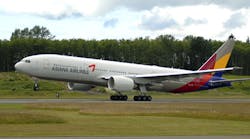Early reports from the scene have experts pointing to pilot error in the crash of a Boeing 777 July 6 at San Francisco International Airport. The pilot had never landed a 777 at the airport before, and had logged only 43 hours at the controls of a 777 before the crash. He had flown approximately 10,000 hours total in his career.
Witness say the plane was low and slow as it made its approach, with the rear of the plane striking the runway and breaking off. As the National Transportation Safety Board begins its investigation, it’s too soon to tell what factor or combination of factors caused the crash of Asiana Airlines Flight 214 with 307 people on board.
New research from the University of North Dakota's John D. Odegard School of Aerospace Sciences aims to eliminate one cause for crashes: decompression and the resulting hypoxia.
Deadly Decompression
There is a reason why flight attendants tell passengers to place the oxygen masks on themselves first and then move to help children and disabled passengers with their masks: It only takes a few seconds for decompression to impact the passengers and crew of an airplane. And those few seconds spell the difference between landing safely or crashing.
“It can happen real fast,” acknowledged Warren Jensen, a flight surgeon and a Chester Fritz Distinguished Professor of Aviation in the University of North Dakota's John D. Odegard School of Aerospace Sciences. Jensen runs the school’s altitude chamber, where students learn to deal with decompression and hypoxia, which occurs the body is deprived of oxygen as an airplane loses cabin pressure. Hypoxia quickly can lead to confusion and blackout, but not if the crew has been trained to recognize what’s going on and takes appropriate action immediately.
“You want to deal with it before the hypoxia impairs you,” said Jensen, who in 2012 ran more than 200 altitude chamber classes for 850 students. “The goal of our altitude chamber training here is to teach students to recognize the symptoms of hypoxia – and they’re different for each person – and to deal with them immediately.”
In an aircraft, decompression-induced hypoxia at high altitude can be fatal, as was likely the case with a Lear 35 that crashed in South Dakota with famed golfer Payne Stewart, friends and crew aboard.
The altitude chamber is used for both aviator training and research, including Fortune 500 corporate pilots. It’s capable of simulating altitudes in excess of 80,000 feet and is used to teach flight crews the physiological affects of high-altitude flight in a safe training environment. Subjects presented in the Aerospace Physiology courses include hypoxia, hyperventilation, cabin decompression issues, visual and spatial disorientation and several other related topics.
Altitude chamber training works.
Dan Fluke, an airline pilot and 2009 graduate of UND Aerospace, always knew he wanted to fly. He also knew he wanted the best training available and all the safety courses available. As part of his training, he took Jensen’s altitude chamber course.
Recently, while flying a commuter jet with 40 passengers aboard, Fluke noticed a familiar and ominous sensation: a numbing feeling, a kind of tingling, that he recognized only because of his UND altitude chamber training.
“I knew what it was right away,” said Fluke, who also runs a business in Florida, writing and publishing aeronautical training guides. “That sensation is what triggered me to look at the indicators, which told me that the aircraft, in fact, was depressurizing. It rang a lot of bells for me, back to my training at UND. You know to go for the mask first rather than fumble with the instruments or worry about other things. You want to get ahead of the situation."
Fluke made a quick decision and made his descent into the closest airport, landing safely.
“I called Doc a couple of days after my decompression incident and thanked him,” Fluke said. “The first signal I felt in that airplane was what I’d felt in Dr. Jensen’s class.”
